Shunde Version Along the River During the Qingming
Qushui Bay

Memorial Archway

Lotus Garden

Round Sky and Square Earth (Tian Yuan Di Fang)

Creek Alley

Cantonese Opera Theatre

Gambiered Canton Silk Experience Shop

Old Green Brick Wall

Manchuria Windows

Stained glass

Oyster shell wall

Wok yi uk

Watch Tower

Shun Mirror

Moments Tower

Shunde Food Museum

Qushui Bay is the largest block type experience business district in South China., with focus on food and culture of Shunde. The design and building of Qushui Bay is inspired by the most renowned Chinese painting Along the River During the Qingming Festival.
The painting captures the daily life of people and the landscape of the capital, Bianjing, today's Kaifeng, from the Northern Song period. The theme is often said to celebrate the festive spirit and worldly commotion at the Qingming Festival. Qushui Bay was designed to be a Shunde version Along the River During the Qingming Festival with scenes revealing the local people lifestyle of the society as well as different economic activities, and offer glimpses of Lingnan culture and architecture through different periods of time from Ming dynasty to contemporary time. The block is composed of three gardens, namely, Lotus Garden, Creek Valley and Cantonese Opera Theater where visitors can taste Shunde food, experience traditional water village life, know about Zhuangyuan culture and folk customs.
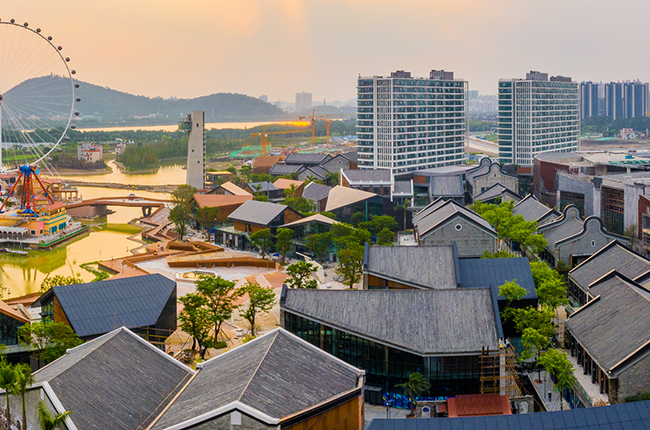
Let us begin our tour from the start point--
Zhuangyuan Memorial Archway
Zhuangyuan in ancient China referred to top academic scholars or military champions selected in imperial examinations. The Zhuangyuan Memorial Archway stands on the central axis of Qushui Bay. The archway is a representation of local spiritual heritage and cultural pride. There were three top academic scholars and one military champion in the history of Shunde. From the Zhuangyuan memorial archway, one can learn about the history, folk custom, belief, glory and dream of Shunde, “A thousand-year water village; a famous town in Lingnan”. The inscription "Shun Tian Ming De" on the front explains the origin of the name of Shunde town; the inscription "Kui Bi Lian Hui" on the back explains the prosperity of Shunde culture.
Lotus Garden—originates from Qinghui Garden with the essence of the spirit of Qingyun
Qinghui Garden is one of the top four Lingnan gardens where they use a lot of objects and plants as symbols in the garden to provide a spiritual utopia for one to connect with nature, to come back to one's inner heart, to come back to ancient idealism. Lotus garden is inspired by the Chengyi Pavilion of Qinghui garden which creates a beautiful scene with the lotus pond and its peaceful and tranquil surroundings. Qingyun Research Institute of Shunde Cultural History was founded in the Lotus garden within which visitors can find the introduction of the history of the famous “ChingWan Cultural Organization” and the origin of Shunde culture of the indigenous community. Different kinds of cultural exchange, exhibition, research and publication, art creation and other activities can be organized here to explore the history of Shunde.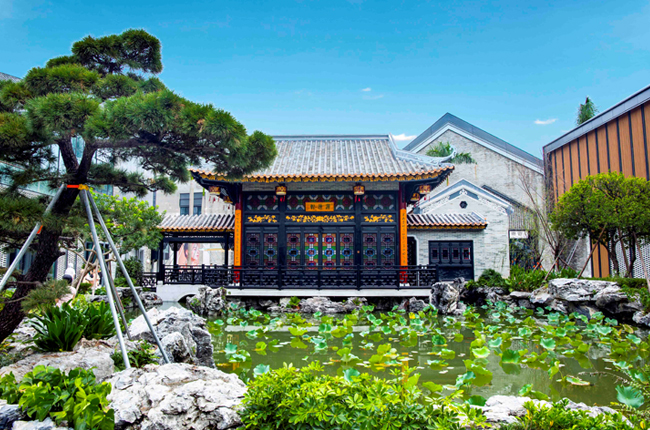
Round Sky and Square Earth(Tian Yuan Di Fang)
Astronomy and geography have been closely connected from the very beginning of Chinese history. What could be called the "scientists" of the ancient time sought to learn the structure of the sky and earth. For several thousand years, there was the general principle of round sky and square earth. Inspired by this ancient concept, modern architects integrates the elements of “pavilions and towers”, the essence of traditional Chinese gardens with modern minimalist design techniques to create a direct dialogue with the classic Lingnan garden Lotus Garden, which symbolizes the inheritance and innovation of Lingnan Garden. The glass roof of the pavilion is imprinted with beautiful Chinese traditional landscape paintings showcasing Shunde thousand-year history and culture.

Creek Alley—an embodiment of Shunde thousand-year history and culture
Inspired by Xintan “Fengjian Water Village”, Water Alley follows the real size of the water passage and showcases the classic water village scene in which many time-honored brands are lined up along the banks. While walking along the water, you can see the buildings decorated with color-stained glasses, shell windows, oyster shell walls and some other traditional southern architecture elements.

Catonese Opera Theatre -originates from Zumiao Temple and a cultural place where traditional Guangfu people assemble
Cantonese Opera is one of the major Chinese opera categories. It is a traditional Chinese art form that originated in Shunde, and involves music, singing, martial arts, acrobatics and acting. There have been many famous Cantonese opera performers in Shunde. To contribute to the inheritance and development of Cantonese opera, the theatre was founded to provide Cantonese opera performers and enthusiasts a space to perform and exchange. The main stage is built with modern steel structure curtain wall mimicking the traditional Cantonese opera stage. Actor lounge, dressing room and other functional rooms are cleverly placed under the stage.
Gambiered Canton Silk Experience Shop
Gambiered canton silk is a kind of silk fabrics stained with botanic dyes by pure-manual weaving which was originally produced mainly in Shunde and Nanhai area. The manufacturing technique of Gambiered Canton Silk has a history of over 500 years and has been listed as an intangible cultural heritage in China. In the 1990s, there was only one Dioscorea cirrhosa Dyeing Factory left in China. In 2009, Gambiered Canton Silk Intangible Culture Preservation Base and Guangdong Gambiered Canton Silk Culture Industrial Park were established in Shunde.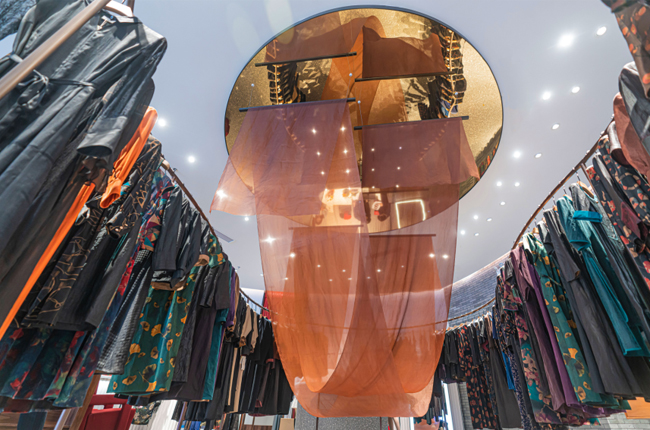
Old Green Brick Wall—assembly of 110,000 old black
bricks
Green brick is a popular building material in the Lingnan region. It is well known for being resistant to changes in temperature and moisture – which makes it very useful for building in the hot and humid Lingnan region. The 110,000 old green bricks were collected from the old buildings and ancestral halls being torn down in different towns of Shunde. A new wall in the Park was then built up assembling all the cleaned and well-cut old bricks with traditional techniques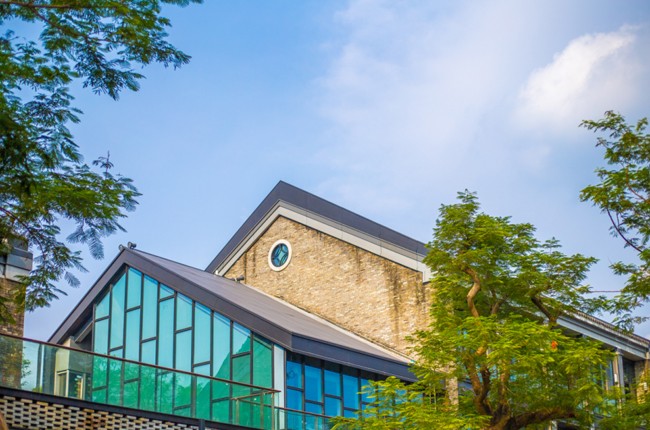
Manchuria Windows: intangible cultural heritage
of Lingnan
Manchuria Windows have been important decorative elements of traditional Lingnan architecture combining Chinese and western culture. It has been listed an intangible cultural heritage. To satisfy the safety and energy conservation needs, the windows are designed with three layers of glasses, with the outside layers made of reinforced glass and the middle layer made of traditional stained glass.
Stained glass—a window of four-season views
This magic is called "a window with four-season views", from which you can see four-season views of a year.
In ancient times, one official from Lingnan returned hometown after retirement. He missed his old days spent in Beijing where he could enjoy snow scenery in winter. Therefore, he had his windows decorated with stained white and blue purple glass through which one could see that everything seemed to be snow covered, just like the northern China scenery in winter. If you look through the stacked white and blue windows, you will see that everything outside is covered with bright red, as if late autumn is coming with red leaves; if you fully open the Manchuria window, you can see a typical garden scenery in spring and summer with evergreen plants, flowers of various colors and chirping birds.

Oyster shell wall: typical Shunde style
The "Oyster Alley" in OCT Happy Harbour PLUS is inspired by the famous scenic spot "Bijiang Jin Lou" in Shunde. For this reason, the design team went all over the world to look for oyster shells. After a series of tedious steps, they finally made a 3-story oyster shell wall.
Oyster shell wall is one of the distinguished features of traditional Lingnan architecture. Qu Dajun (1630—1696), a famous scholar and poet of Panyu, Guangzhou recorded the use of oyster shells to build walls in his Guangdong Neo-analects.
The Pearl River Delta is rich in aqua products like oysters. Local people mixed oyster shells with yellow mud, brown sugar and steamed glutinous rice which were then piled up layer after layer to build houses. Oyster shell houses were said to be very sturdy, sound proof and warm in winter and cool in summer. It was said that the walls can be bullet proof. With the unique oyster shell shapes, oyster shell wall also has a high aesthetic value.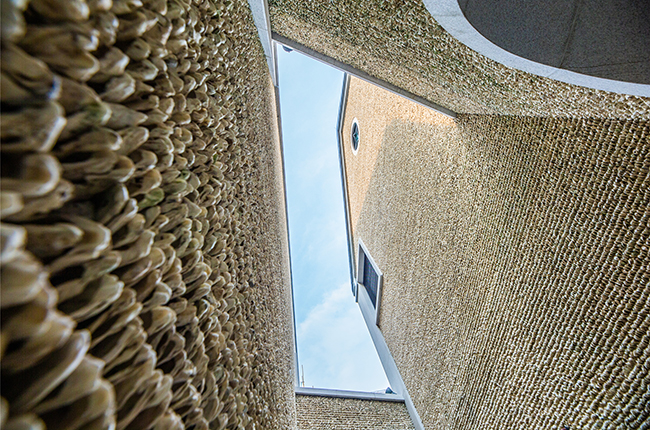
Wok yi uk (Chinese: literally “house with wok ears”) is a distinct characteristic in Lingnan architecture
Wok yi uk (Chinese: literally “house with wok ears”) is a distinct characteristic in Lingnan architecture. It is a building that has a pair of building that has a pair of curved walls protruding vertically at both ends of its roof, usually seen in traditional residential buildings. It emerged at around 15th century, during which Lingnan was ruled by the Ming Empire. It was a tradition to build such walls for people who have been granted honors through the empire’s examination system. This later evolved into the belief that building such walls could help one’s sons and grandsons attain similar honors. It also has more practical purposes, however – having the two walls protruding from both ends of the roof could help reduce the amount of sunlight directly shining on the roof, resulting in lowered temperature. This is useful in the subtropical Lingnan region.
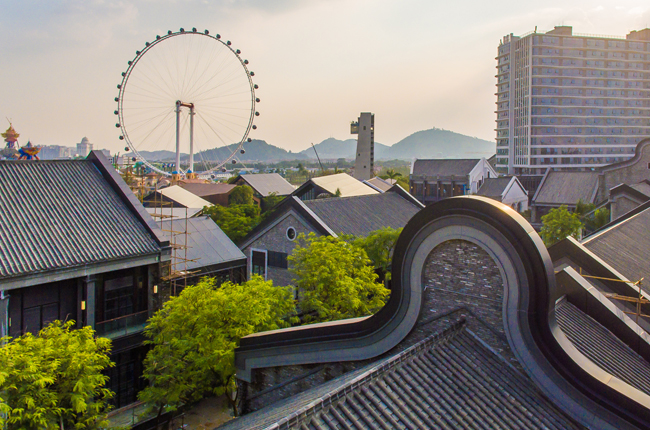
Watch Tower
Watch tower was a typical Lingnan style resident building. The watch tower in the Park was built to honor this unique Lingnan architecture. The 25-meter watch tower has five stories with the outside layer built with hollow brick walls. At night, visitors can enjoy light mapping shows on the watch tower equipped with laser and projection lights.
Shun Mirror
Shun Mirror is the representative of post-modern "deconstruction architecture" of OCT Happy Harbour PLUS. It is composed of 1,223 mirror polished stainless steel plates which altogether covers 2,300 square meters. It is the only mirror stainless steel art device that stands 35 meters over the ground in China. It is also the largest single art project of this kind in the world. This art project wants to highlight the spirit of exploration and innovation spirit by showcasing Shunde people's spirit of "competing for the best, daring to be the first" and the humanistic spirit of the Great Navigation Era of "daring to take risks, daring to explore".
Moments Tower
The 38.8 meter lighthouse was designed by Zhu Pei, a famous Chinese architect. The architect cleverly used the concept of Chinese traditional origami to design this landmark building with simple and elegant form in the lake with reasonable structure and rich space. At the glass curtain wall of the sightseeing elevator and the glass handrail of the rooftop of the lighthouse, the introduction of 26 cities of gastronomy in the world is imprinted, which becomes the window to showcase the cities of gastronomy to the world. The lighthouse building is equipped with pattern projection lights and tower top laser lights, which forms the main part of the light show of OCT Happy Harbour PLUS. The light tower takes the baton of all the space shows and is also the location of the member center.
Shunde Food Museum is the historical and cultural corridor of Cantonese cuisine with Chinese food and culture as the background. The museum, as a premium local cuisine museum in China, will showcase the assets of Shunde food and culture thoroughly together with Quishui Bay, the largest block type experience business district in South China. Qushui Bay was designed to be a Shunde version Along the River During the Qingming Festival (the most renowned Chinese painting) with scenes revealing the local people lifestyle of the society as well as different economic activities, and offer glimpses of Lingnan culture and architecture through different periods of time. Visitors can taste Shunde food, experience traditional water village life,know about Zhuangyuan culture and folk customs strolling in the block.





 粤公网安备 44060602001404号
粤公网安备 44060602001404号